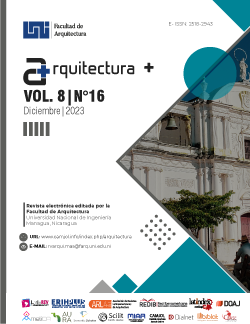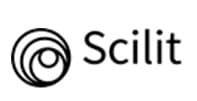Variaciones en los tiempos de captura en la elaboración de modelos de nubes de puntos con Escáner Láser Terrestre por condiciones de campo
DOI:
https://doi.org/10.5377/arquitectura.v8i16.17153Palabras clave:
Escaneo-láser, estimaciones, patrimonio, tecnología, TLSResumen
Los láser escáneres tienen una configuración para la captura 3D en el cual, para determinada densidad (baja, media y alta) se cuenta con tiempos específicos. Para densidades bajas el tiempo que se puede tardar en realizar una captura de nubes de puntos con RGB es cerca de los 7 minutos. Sin embargo, los tiempos de captura de campo no dependen solamente de la configuración del equipo, sino que es necesario tener en cuenta una serie de factores humanos que intervienen en el trabajo de campo, tales como (a) el seguimiento de una planeación, (b) el tiempo de colocación y ajuste del trípode por estación, (c) la colocación y ajuste de los targets y (d) la nivelación de la estación. Estos factores son aleatorios porque son factores humanos. Entonces, ¿Cuánto puede variar el tiempo de captura de campo considerando las condiciones humanas? El objetivo de este estudio fue estimar el tiempo aproximado de captura por estaciones durante un levantamiento 3D de un edificio con un TLS modelo Leica ScanStation C10. Para estimar el tiempo promedio de levantamiento, se analizaron 3 casos de estudios: Regina 143, Escuela Belisario Domínguez y la Capilla del Museo ExTeresa Arte Actual (CMEAA). Se estimaron medias, medianas y desviaciones estándares de las capturas con resoluciones bajas para nubes de puntos y para RGB. Se encontró que el tiempo medio de captura por estación fue de 12 minutos 30 segundos, con desviaciones estándares de 4 minutos y 36s. El tiempo que tarda la cuadrilla de trabajo de campo en realizar actividades de ajustes, en promedio, es de 2 minutos y 44 segundos. Estos datos son de utilidad para la planeación de proyectos de levantamiento con instrumentos similares.
Descargas
823
Citas
Abdel-Bary Ebrahim, M. (2011). 3D laser scanners: History, applicatiosn and future. Assiut, Egypt: Assiut University.
Aguilar, F. J., Nemmaoui, A., Peñaver, A., Rivas, J. R., & Aguilar, M. A. (2019). Developing Allometric Equations for Teak Plantations Located in the Coastal Region of Ecuador from Terrestrial Laser Scanning Data. Forest, 10(1050). doi:10.3390/f10121050
Castagnetti, C., Bertacchini, E., Capra, A., & Dubbini, M. (2012). Terrestrial Laser Scanning for Preserving Cultural Heritage: Analysis of Geometric Anomalies for Ancient Structures. FIG Working Week 2012. Rome, Italy. Obtenido de https://iris.unimore.it/handle/11380/746897
Dallas, R. (2003). Measured Surveys of Historic Buildings: User Requirements and Technical Progress. Journal of Architectural Conservation, 9(2), 58-81. doi:10.1080/13556207.2003.10785343
Eld, M., Mizerák, M., & Trojan, J. (2018). 3d Laser Scanner: History and Applications. Acta Simulatio, 1-5. doi:10.22306/asim.v4i4.54
González-Aguilera, D., Muñoz-Nieto, A., Gómez-Lahoz, J., Herrero-Pascual, J., & Gutierrez-Alonso, G. (2009). 3D Digital Surveying and Modelling of Cave Geometry: Application to Paleolithic Rock Art . Sensors , 9(2), 1108-1127. doi:10.3390/s90201108
Idrees, M. O., & Pradhan, B. (2016). A decade of modern cave surveying with terrestrial laser scanning: A review of sensors, method and application development. International Journal of Speleology, 45(1), 71-88. doi:10.5038/1827-806X.45.1.1923
Klapa, P., Mitka, B., & Zygmunt, M. (2017). Application of Integrated Photogrammetric and Terrestrial Laser Scanning Data to Cultural Heritage Surveying. IOP Conf. Series: Earth and Environmental Science, 95(2017). doi:10.1088/1755-1315/95/3/032007
Komsta, L. (2022). Package ‘outliers’. Repository CRAN. Obtenido de https://search.r-project.org/CRAN/refmans/outliers/html/rm.outlier.html
Kwoczyńska, B., Litwin, U., Piech, I., Obirek, P., & Śledź, J. (2016). The Use of Terrestrial Laser Scanning in Surveying Historic Buildings. 2016 Baltic Geodetic Congress . Poland: IEEE. doi:10.1109/BGC.Geomatics.2016.54
Lee, S. Y., Majid, Z., & Setan, H. (2013). 3D DATA ACQUISITION FOR INDOOR ASSETS USING TERRESTRIAL LASER SCANNING. ISPRS Annals of the Photogrammetry, Remote Sensing and Spatial Information Sciences,Volume II-2/W1, ISPRS 8th 3DGeoInfo Conference & WG II/2 Workshop. Istanbul, Turkey.
Mat-Zam, P., Fuad, N., Yusoff, A., & Majid, Z. (2018). EVALUATING THE PERFORMANCE OF TERRESTRIAL LASER SCANNING FOR LANDSLIDE MONITORING. International Conference on Geomatics and Geospatial Technology. Kuala Lumpur, Malaysia. Obtenido de https://doi.org/10.5194/isprs-archives-XLII-4-W9-35-2018
Mukupa, W., Roberts, G. W., Hancock, C. M., & Al-Manasir, K. (2016). A review of the use of terrestrial laser scanning application for change detection and deformation monitoring of structures. Survey Review. doi:10.1080/00396265.2015.1133039
Pritchard, D., Sperner, J., Hoepner, S., & & Tenschert, R. (2017). Terrestrial laser scanning for heritage conservation: the Cologne Cathedral documentation project. ISPRS Annals of the Photogrammetry, Remote Sensing and Spatial Information Sciences, 4, págs. 213-220. Ottawa, Canada. doi:10.5194/isprs-annals-IV-2-W2-213-2017
Remondino, F. (2011). Heritage Recording and 3D modeling with photogrammetry and 3d scanning. Reomete Sensing, 1104-1138. doi:10.3390/rs3061104
Ryding, J., Williams, E., J. Smith, M., & Eichhorn, M. P. (2015). Assessing Handheld Mobile Laser Scanners for Forest Surveys. Remote sensing, 2015(7), 1095-1111. doi:10.3390/rs70101095
Sirmacek, B., Shen, Y., Lindenbergh, R., Zlatanova, S., & Diakite, A. (2016). COMPARISON OF ZEB1 AND LEICA C10 INDOOR LASER SCANNING POINT CLOUDS. ISPRS Annals of the Photogrammetry, Remote Sensing and Spatial Information Sciences, Volume III-1, 2016. Prague, Czech Republic. doi:10.5194/isprsannals-III-1-143-2016
Soudarissanane, S. S., & Lindenbergh, R. C. (2011). Optimizing terrestrial laser scanning measurement set-up. SPRS Workshop Laser Scanning. Calgary, Canada. doi:10.5194/isprsarchives-XXXVIII-5-W12-127-2011
Suchocki, C., Dami˛ecka-Suchocka, M., Katzer, J., Janicka, J., Rapinski, J., & Stałowska, P. (2020). Remote Detection of Moisture and Bio-Deterioration of Building Walls by Time-Of-Flight and Phase-Shift Terrestrial Laser Scanners. Remote Sensing. doi:10.3390/rs12111708
Tremblay, J.-F., & Béland, M. (2018). Towards operational marker-free registration of terrestrial lidar data in forests. ISPRS Journal of Photogrammetry and Remote Sensing, 146(2018), 430-435. doi:10.1016/j.isprsjprs.2018.10.011
Wu, C., Yuan, Y., Tang, Y., & Tian, B. (2022). Application of Terrestrial Laser Scanning (TLS) in the Architecture, Engineering and Construction (AEC) Industry. Sensors. doi:10.3390/s22010265
Descargas
Publicado
Cómo citar
Número
Sección
Licencia
Derechos de autor 2023 Universidad Nacional de Ingeniería

Esta obra está bajo una licencia internacional Creative Commons Atribución-NoComercial-SinDerivadas 4.0.



















